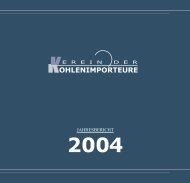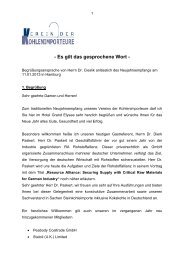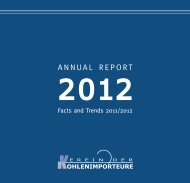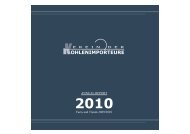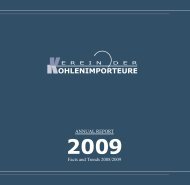Annual Report 2010 - Verein der Kohlenimporteure eV
Annual Report 2010 - Verein der Kohlenimporteure eV
Annual Report 2010 - Verein der Kohlenimporteure eV
You also want an ePaper? Increase the reach of your titles
YUMPU automatically turns print PDFs into web optimized ePapers that Google loves.
According to information from Vinacom, port capacities<br />
amount to about 34 Mtpa:<br />
Export and Port Capacities in Vietnam<br />
Port Mt<br />
Cam Pha/Cua Ong 15.0<br />
New ports in Cam Pha 10.0<br />
Hon Gai/Nam Cau Trang 3.0<br />
Hon Gai/Dien Väng 1.5<br />
Hon Gai/Troi 1.5<br />
Uong Bi/dien Cong 3.0<br />
Total<br />
LBT33<br />
34.0<br />
Exports<br />
In <strong>2010</strong>, seaborne exports dropped again by almost<br />
<br />
further decrease to 16.5 Mt is expected since domestic<br />
consumption is expected to increase by about 4.2<br />
<br />
In addition to China, Japan, Thailand and South Korea<br />
bought smaller quantities. Vietnamese anthracite coal is<br />
also partly used as PCI coal and sales improved because<br />
of the continued recovery of the steel industry.<br />
A high proportion of Vietnamese anthracite steam coal<br />
exports are of low calorific and only profitable because<br />
of the short sea routes to China. This coal would not<br />
be commercially competitive on the international steam<br />
coal market. Nevertheless, it covers demand which<br />
otherwise might have to be satisfied by purchases on<br />
the world market and thus alleviates pressure on this<br />
market. A small part of the exports also goes overland<br />
to China.<br />
Key Figures Vietnam<br />
2008<br />
Mt<br />
2009<br />
Mt<br />
<strong>2010</strong><br />
Mt<br />
Output 40.0 43.0 50.0 1)<br />
Exports<br />
19.4 25.1 20.8<br />
thereof to China<br />
16.9 24.1 18.0<br />
Export Rate in % 48.5 58 42<br />
1) <br />
LB-T34<br />
<br />
In <strong>2010</strong>, China drove the global economy with its<br />
continued growth, albeit slightly slower than in recent<br />
years. GDP increased again by around 10%. The<br />
growth was supported by a massive economic stimulus<br />
programme, which focused on infrastructure expansion.<br />
This, together with further urbanisation in China,<br />
drove demand for steel, cement and electricity. China<br />
generated 80% of its electricity from coal. Demand for<br />
coal increased accordingly.<br />
Electric Power / Crude Steel / Pig Iron /<br />
Coal Production<br />
2008 2009 <strong>2010</strong><br />
Power Generation TWh 3,405 3,664 4,207<br />
Crude Steel Production Mt 502 568 627<br />
Pig Iron Production Mt 471 544 590<br />
Coal Production<br />
LB-T35<br />
Mt 2,716 2,910 3,410<br />
The Chinese economy continues to grow strongly, with<br />
standard of living and levels of education also increasing.<br />
There are nevertheless tensions, given the huge divide<br />
between rich and poor. There have been protests against<br />
the high rate of inflation, against low wages and against<br />
bad working conditions.<br />
China was however able to distance itself from the<br />
ongoing effects of the global economic crisis by<br />
stimulating domestic demand.<br />
81



